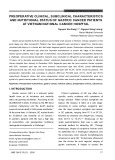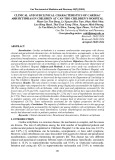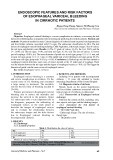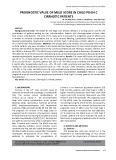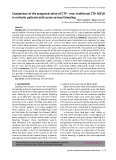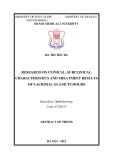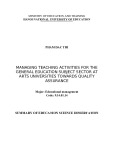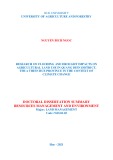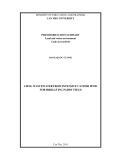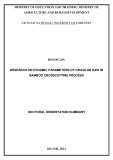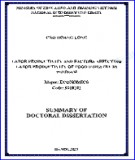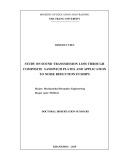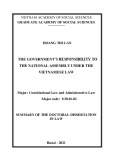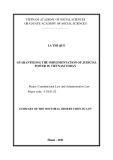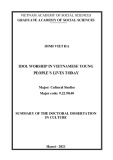MINISTRY OF EDUCATION AND TRAINING
MINISTRY OF DEFENCE
VIETNAM MILITARY MEDICINE UNIVERSITY
======
DUONG QUANG HUY
RESEARCH ON CLINICAL AND SUBCLINICAL
CHARACTERISTICS, CARDIAC MORPHOLOGY AND
FUNCTION IN CIRRHOTIC PATIENTS
Specialized: Internal Medicine Gastroenterology Code: 62 72 01 43
THESIS OF MEDICAL DOCTOR OF PHYLOSOPHY
SCIENCE INSTRUCTORS
1. Assocociate Professor. Ph.D Tran Viet Tu
2. Ph.D Hoang Dinh Anh
Ộ HÀ N I2015
1
INTRODUCTION
Cirrhosis is a quite common disease in many countries all over the world including Vietnam, an important issue to community health, and one of the causes of high mortality in comparison to other diseases. Cirrhosis has a variety of clinical manifestations and complications in many organs such as hepatic encephalopathy, hepatorenal syndrome, hepatopulmonary syndrome, etc.. In addition, cirrhosis has harmful effects on cardiovascular system.
Effects of cirrhosis on cardiovascular system were recognized by Kowalski and Albeman more than 60 years ago. So far a series of research works all have identified uniformly that in cirrhotic patients there are symptoms of hyperdynamic circulation, normal left ventricular systolic function (SF) at rest but impaired ventricular contractility in response to stimuli with confusion of diastolic function (DF) and prolonged electrocardiographic QTc interval. A group of all these abnormalities was called as a term of cirrhotic cardiomyopathy by the World Congress of Gastroenterology held in Montreal in 2005. Cirrhotic cardiomyopathy is an independent entity that is different from alcoholic cardiomyopathy as well as other primary cardiomyopathy diseases.
Cirrhotic cardiomyopathy plays an important role in pathophysiological mechanism of salt and water retention, hepatorenal syndrome and hepatopulmonary syndrome, and it is one of the factors that contribute to cause mortality of cirrhotic patients. Besides, many evidences show that cardiovascular abnormalities will be exposed or heavier after transjugular intrahepatic portosystemic shunt (TIPS) insertion or liver transplant (27% significant rhythmmias, more than 50% acute pulmonary edema, nearly 50% cardiac decompensation after transplantation). Cardiac cause account for 7 – 15% of deaths in the post operative period, one of the major causes after rejection and infection.
Nowadays in Vietnam, many advances in cirrhotic treatment have been applied such as transjugular intrahepatic portosystemic shunt insertion, liver transplant but effects of cirrhosis on cardiovascular system (an important factor that could contribute to prognosis and selection of patients for intervention) have not been really research interest. Therefore, we conducted the project of “Research on clinical
2
and subclinical characteristics, cardiac morphology and function in cirrhotic patients”. 1. Goals of the project 1.1. Reviewing some clinical and subclinical symptoms, cardiac morphology and function via ultrasonography in cirrhotic patients.
1.2. Identifying a relationship between some parameters of cardiac morphology and function and some clinical and subclinical symptoms in cirrhotic patients. 2. New contribution of the thesis
This is the first work in Vietnam to research relatively comprehensively and systematically for affirmation of that there is change of cardiac morphology and function in cirrhotic patients, namely:
In cirrhotic patients there were changes of cardiac morphology on echocardiography, that was clear increase of dimensions of the left atrium and the right ventricle, slight increase of diastolic interventricular septum thickness and left ventricular mass. The changes were not affected by causes and/or degree of cirrhosis.
Left ventricular SF (evaluated via ejection fraction) was normal at rest but DF was clear confusion, it showed decrease of E/A ratio, lengthening of deceleration time of earlydiastolic filling wave and isovolumic relaxation time. Ratio of left ventricular diastolic dysfunction was 70.9%, in which diastolic dysfunction at stage 1 was 34.2%, stage 2 was 35.0% and there are 2 patients of diastolic dysfunction at stage 3. The increasing cirrhotic degree was the more and heavy diastolic dysfunction was.
Systolic pulmonary arterial pressure (estimated via tricuspid insufficiency) increased in cirrhotic patients (30.04 ± 5.81 mmHg) but mainly increase at mild degree (48.9%). Higher increasing degree was seen in a group of ChildPugh C cirrhosis. 3. The layout of the thesis The thesis consists 136 pages, including:
2 pages of introduction, 33 pages of literature review, 24 pages of research method, 39 pages of research result, 36 for discussion and 2 for conclusion.
3
The thesis contains 41 tables, 2 diagrams, 7 charts and 18 pictures. The thesis contains 158 references, including 10 materials in Vietnamese and 148 materials in English.
4
CHAPTER 1 LITERATURE REVIEW 1.1. Conspectus of cirrhosis
Cirrhosis is the final consequence of chronic liver injury that leads to fibrosis and nodules pervading hepatic lobules, inverting irrecoverably structure of lobules and intrahepatic blood vessel. This is a quite common disease, in an increasing trend in almost countries in the world, and one of the causes of high mortality in comparison to other diseases as its heavy complications.
Cirrhosis develops naturally in 2 stages. The first is a period of non or few symptoms, called as a stage of compensated cirrhosis, then other stage is rapid progression remarked by appearance of PVH’s complications and/or loss of liver function such as ascites, hepatic gastrointestinal bleeding caused by portal hypertension, encephalopathy and jaundice. Appearance of one of the complications is a sign of that cirrhosis transfers from a compensated stage to a decompensated stage. Diagnosis of cirrhosis in compensated stage sometime is difficult as unclear manifestations of symptom that need laparoscopy and liver biopsy. In decompensated stage diagnosis becomes easier with all 2 syndromes of liver failure and PVH, unneccessary to do liver biopsy. 1.2. Cardiac change in cirrhotic patients
kidney
Cirrhosis might cause harmful effects on functions of almost organs in the body such as brain (hepatic encephalopathy), lung (hepatorenal syndrome)... (hepatopulmonary syndrome), Furthermore, cirrhosis also drags a series of cardiovascular abnormalities. These cardiovascular abnormalities include: 1.2.1. Change of cardiac morphology With different
diagnostic techniques including cardiac ultrasonography, cardiac magnetic resonance imaging, radionuclide angiography, researches indicate that in cirrhotic patients there is change of cardiac morphology (particularly the left heart), that is: increased ventricular wall thickness, increased size and volume of left cardiac ventricle, left ventricular hypertrophy in some patients. Researches on anatomy of corpse’s heart of cirrhotic patients acknowledge high proportion of cardiomegaly with structural change of cardiac histology
5
such as oedema, myocardial cell hypertrophy, interstitial fibrosis and nucleus vacuole. 1.2.2. Change of SF In cirrhotic patients
there is symptoms of hyperdynamic circulation (increased heart rate and cardiac output, low systemic vascular resistance and arterial blood pressure), while ejection fraction (EF%) is always normal or even increases at rest. However under conditions of stress, whether physical or pharmacological there exposes clearly reduced myocardial contractility or systolic incompetence, and this is an element that contributes to pathogenesis of hepatorenal syndrome as well as water and salt retention in cirrhotic patients.
Hyperdynamic circulation becomes more serious after installation of TIPS because TIPS produces an acute increase in preload, leading to some cardiovascular complications such as acute pulmonary oedema, congestive heart failure although quite rarely (about 1%) but it needs to be considered in indication and requires close monitoring after intervention. 1.2.3. Change of DF
Diastolic dysfunction (DD) is common phenomenon in cirrhotic patients, that demonstrates in such major parameters as decrease of E/A ratio, lengthening of isovolumic relaxation time (IVRT) and Ewave deceleration time (DT). Proportion of cirrhotic patients with diastolic dysfunction is about 40–70% depending on diagnostic methods (with or without tissue Doppler imaging), in which almost DD at stage 1 and 2, proportion of DD at stage 3 is very low (< 3%). DD is an important element that contributes to prognosis of mortality risk and effective prediction of using TIPS. 1.2.4. Change of pulmonary artery pressure (PAP)
Increase of PAP is one complication of cirrhosis, is called as a term of “portopulmonary hypertension”. Proportion of portopulmonary hypertension is 0.614% number of the cirrhotic patients in general but that can be up to 8.5% in the patients with endstage liver disease waiting for liver transplant with faint clinical manifestation that is easy to be ignored, however it can progress to right heart failure and mortality (proportion surviving after 5 years in cirrhotic patients with portopulmonary hypertension is only 14%)
6
Screening of PAP increase in cirrhotic patients waiting for liver transplant is obligatory because in case of that mean PAP (measured via cardiac catheterization) increase between 35 – 45 mmHg (moderate increase) is relative contraindication, while increase more than 45 mmHg (heavy increase) is absolute contraindication as increasing risk of right heart failure after transplant and the patient will die because of transthoracic cardiac Screening tool is acute liver failure. ultrasonography to estimate systolic PAP regularly every 6 months, if systolic PAP is more than 45 mmHg there needs indication of cardiac catheterization to identify portopulmonary hypertension. 1.3. Pathogenic mechanisms of changing cardiac morphology and function in cirrhotic patients
Change mechanisms of cardiac morphology and function in cirrhotic patients are very complicated, with many influential elements including unfavourable factors such as anemia, electrolyte disturbances, intoxication, and impact of causes from alcohol, hepatitis C, etc., as well as favourable factors. Favourable factor is afterload reduction caused by rise of such vasodilators as glucagon, cannabinoid, etc. and decrease of blood vessel’s response to endogenous vasoconstrictor. Almost researches demonstrate that preload in cirrhotic patients usually reduces (or being normal) caused by vasodilation, forms portosystemic collateral circulation and phenomenon of water retention in the body's natural cavities.
So far a series of different research works on experimental animals and cirrhotic patients have agreed that change of cardiac morphology and function in cirrhotic patients is general result of 3 directly influential mechanisms on myocardium, those are: Intensity of Aldosterone (by reduction of degradation in liver and by activating system of renin – angiotensin – aldosterone (RAA))
Reduction of activity of sympathetic nervous system in heart High increase of substances with negative impacts on cardiac function such as nitric oxide (NO), carbon monoxide (CO), endothelin … and many other poisons caused by impaired liver function and PVH. 1.4. Research situation on cardiovascular abnormalities in cirrhotic patients in Vietnam
7
In Vietnam, many advances in cirrhotic treatment have been applied (TIPS, liver transplant), many researches on cirrhosis have been conducted but non research on evaluating change of cardiac morphology and function. Therefore, we conducted this research with hopefulness of that it could help clinicians to more understand comprehensively about unfavourable impacts of cirrhosis on organs in the body those not only are brain, kidney, lung… but also impact deeply cardia with a term of cirrhotic cardiomyopathy. Moreover, the research results hopefully might contribute to selection of liver transplant patients and TIPS, prediction of cardiovascular events as well as prognosis after intervention treatment.
CHAPTER 2 RESEARCH MATERIALS AND METHODS 2.1. Study population Between March of 2012 and September of 2014, we conducted
the research with 162 objects divided into 2 groups: 2.1.1. Control group: There were 45 people who were selected in according to following criteria: No a history of liver disease as well as diseases of the cardiovascular, endocrine, metabolism, kidney – urology, respiration… Normal results of clinical examinations and tests
(echocardiogram, hepatic and cardiac ultrasonography). 2.1.2. Patient group
There included 117 patients who were diagnosed with cirrhosis in subclasses of ChildPugh B and ChildPugh C (patients are of both clear 2 syndromes of hepatic dysfunction and PVH combining with change of hepatic morphology on ultrasound) and inpatients in Department of Digestion – Military Hospital 103. Some exclusion criteria in treatment group:
Cirrhotic patients with such heavy complications as recent gastrointestinal bleeding, cerebral hemorrhage, cancerization, severe anemia (Hemoglobin < 70g/l)… Patients who were treating with any drug which could affect β cardiac function such as blockers, nitrates...
8
Patients with a history of past or present cardiac disease, bronchopulmonary diseases or diseases affecting cardiac function such as diabetes, Basedow,… Window for hepatic and cardiac ultrasonography did not meet a technical requirement. Patients who did not agree to participate in the research.
2
2.2. Research method 2.2.1. Research design: crosssectional description, with comparison between patient group and control group. 2.2.2. Sample selection Application of formula for sample size calculation to research of crosssectional description:
qp .
a
1
(cid:0)
Z
(cid:0)
n
. 2/ 2
d
With selection of proportion 51.1% (p = 0.511) (proportion of cirrhotic cardiomyopathy in research by Belay T et al. in 2013) in formula for sample size calculation, we collected result of minimal sample size of 96 patients. We chose 117 patients for this research. 2.2.4. Steps of conducting research: following a unified form for all research objects. Clinical examinations: medical history (alcoholism, infection with hepatitis viruses), symptoms of hepatic dysfunction and PVH Blood tests: Complete blood count (noting number of platelet), blood chemistry (Albumin, total bilirubin, AST, ALT), function of blood coagulation (Prothrombin ratio), virusmarkers (qualitative HBsAg and anti HCV). Cirrhosis is classified by ChildPugh score scale. ECG and chest Xray Esophagogastroscopy: Evaluation of OV recreational stage (F0, F1, F2, F3) according to the Japan Society for Portal Hypertesion 3th edition (2010). Hepatic ultrasonography: identification of status of liver tissue, liver edge, splenic size, peritoneal fluid, especially stydying hemodynamics of hepatic vessel, including portal vein (PV), hepatic artery (HA), hepatic vein (HV). Echocardiography
9
+ Evaluation of left ventricular morphology and SF: by parameters measured on 2D and TM ultrasonography.
+ Evaluation of left ventricular DF: using impulse Doppler ultrasonography with flow through the mitral valve in combination with Valsalva maneuver and pulmonary venous Doppler to classify stage of DD according to the American Society of Echocardiography 2009. + Evaluation of right ventricular Tei index and DF (Doppler spectrum with flow via tricuspid valve). + Evaluation of systolic PAP (for objects with tricuspid
insufficiency) 2.3. Statistical analysis: All data is processed in software of Excel plus and SPSS 20.0 right according to the statistical algorithms.
CHAPTER 3 RESEARCH RESULTS
3.1. Clinical and subclinical characters in cirrhotic patients 3.1.1. Age and sexual characters of cirrhotic group
The 85.5% of patients were males; the malefemale ratio was 61. Average age of cirrhotic group was 52.40 ± 12.23, in which the most common age was between 40 and 59 with 60.7%. There was not any difference in sex, average age and classification of age between cirrhotic group and control group, p > 0.05. 3.1.2. Causative factors and some clinical and subclinical symptoms in cirrhotic patients
Alcohol was the major cause in relation to cirrhosis (45.3%), followed by infection with hepatitis B and/or C viruses (35.9%). There were cirrhotic patients with unidentified cause (counting 1.7%).
Clinical symptoms of common hepatic dysfunction syndrome were frequently fatigue (91.5%), dyspepsia (88.0%), jaundice (84.6%), and oedema (61.5%). Tests for evaluation of hepatic function:
blood Albumin decreases less than 35 g/l in 96.6%, total Bilirubin increases more than 51µmol/l in 54.7%, and Prothrombin ratio decreases less than 54% in 60.7% of cirrhotic patients.
Symptoms of PVH: 100% of the patients being OV on endoscopy, in which mostly varice at stage 3 (counting 50.5%), 80.3%
10
of the patients being PV diameter of more than 13mm on ultrasonography, 77,8% of the patients being splenomegaly and decreased platelets less than 100G/l, 68.4% of the patients being ascites. Cirrhotic patients in a stage of ChildPugh B were 46.2% and of
ChildPugh C are 53.8%. 3.1.3. Hemodynamic character of hepatic vessels on colour Doppler ultrasonography
There were abnormalities of direction of portal venous flow in 13 cirrhotic patients (9 patients with bidirectional flow, 4 patients with hepatofugal flow), counting 11.3%. Three patients had unidentified portal venous flow and four patients (3.4%) had portal vein thrombosis.
In cirrhotic patients with hepatopedal flow and without thrombosis it could be seen relaxation of PV and increased thickness of portal venous wall, decreased velocity and capacity of portal venous flow, that are clearly different from control group, p < 0.01.
Diameter of HA increased with acceleration of systolic flow and increase of impedance index. The difference from control group is significant statistically, p < 0.01. Diameter and velocity of systolic flow of HV decreased more clearly than that in control group, p < 0.01.
The 86.7% of control group had normal HV waveforms, while in cirrhotic group, normal HV waveforms was only seen in 8.6% of the patients, the rest of 47.0% transfered to biphasic waveforms and 44.4% to flat waveforms.
In group of cirrhotic patients with decrease of portal venous velocity of less than 1.0 litre/minute, systolic diameter and velocity of HA, diameter and velocity of HV were all statistically lower than that of cirrhotic group with normal portal venous flow, p < 0.050.01. Velocity of hepatic vein was positively correlated with portal
venous flow (correlation coefficient r = 0.40, p < 0.01). 3.2. Characters of cardiac morphology and function, and systolic PAP in cirrhotic patients 3.2.1. Characters of cardiac morphology and function in cirrhotic patients * Characters of cardiac morphology in cirrhotic patients Table 3.14. Size of cardiac chamber and thickness of ventricular wall
11
in cirrhotic group and control group
p Index
Control group (n = 45) 21.24 ± 1.54 31.58 ± 2.95 48.42 ± 3.43 30.20 ± 3.11 7.60 ± 0.50 7.56 ± 0.55 129.62 ± 22.41 Cirrhotic group (n = 117) 22.24 ± 3.22 36.52 ± 4.86 48.68 ± 5.33 30.27 ± 3.99 7.92 ± 0.99 7.59 ± 0.70 137.71 ± 33.94 < 0.01 < 0.01 > 0.05 > 0.05 > 0.05 > 0.05 > 0.05 RVDd (mm) LA (mm) Dd (mm) Ds (mm) IVSd (mm) LWd (mm) LVM (g)
Cirrhosis caused enlargement of left atrium and right ventricle (p < 0.01) but unchange of left ventricular size and wall thickness as well as mass in comparison to that in control group (p > 0.05). * Characters of left ventricular SF in cirrhotic patients: In cirrhotic patients, ejection time of left ventricle shortened, cardiac output increased highly while volume of left ventricle and ejection fraction only rose slightly with statistic insignificance in comparison to that in control group, p > 0.05. * Characters of left ventricular DF in cirrhotic patients
Table 3.16. Left ventricular Tei index and DF in cirrhotic group in comparison to control group
Index p
< 0.01 < 0.01 < 0.05 < 0.01 > 0.05
Control group (n = 45) 69.61 ± 14.27 63.63 ± 13.78 1.12 ± 0.25 176.31 ± 10.33 70.22 ± 11.14 83.73 ± 8.24 Cirrhotic group (n = 117) 79.48 ± 21.15 80.89 ± 22.34 1.02 ± 0.33 183.19 ± 21.93 68.91 ± 12.97 92.64 ± 14.38 < 0.01
0.50 ± 0.03 0.61 ± 0.08 < 0.01 VE (cm/s) VA (cm/s) E/ A DT (ms) AT (ms) IVRT (ms) Left ventricular Tei index
12
E/A ratio decreased, deceleration time DT and isovolumic relaxation time IVRT prolonged in cirrhotic group in comparison to that in control group, p < 0.05 – 0.01. Table 3.17. Proportion of left ventricular DD in cirrhotic patients
DF Number Proportion % No 34 29.1
Yes 83 70.9 DD (n = 117) Stage 1 40 34.2 Stage of DD Stage 2 41 35.0
Stage 3 2 1.7
70.9% of cirrhotic patients in the research had DD, in which mostly DD at stage 1 and 2 (counting 34.2% and 35.0% respectively), there are only 2 patients with DD at stage 3 (counting 1.7%). * Characters of right ventricular Tei index and DF in cirrhotic patients: There was visible change of index of right ventricular DF in cirrhotic patients in comparison to that in control group, specifically increase of VER, reduction of ER/AR ratio, p < 0.05 0.01. Right ventricular Tei index in cirrhotic group was 0.23 ± 0.05, lower than that of control group with 0.27 ± 0.04, p < 0.01 3.2.2. Change of systolic PAP in cirrhotic patients The 90 cirrhotic patients and 22 people of control group had mild tricuspid regurgitation.
Mean systolic PAP in the group of cirrhotic patients was 30.04 ± 5.81 mmHg, being higher than that of control group with 24.64 ± 4.25 mmHg, p < 0.01.
50.0% of cirrhotic patients increased systolic PAP in which the majority was slight increase (< 50 mmHg) (counting 48.9%). There was not any cirrhotic patient who had systolic PAP over 70 mmHg.
Cirrhotic group with ChildPugh C had higher systolic PAP increase than that of cirrhotic group with ChildPugh B (31.30 ± 6.49 vs 28.48 ± 4.43 mmHg, p < 0.05). There was not any difference in systolic
13
PAP between cirrhotic subgroups based on OV level on endoscopy as well as between cirrhotic groups with and without ascites, p > 0.05. 3.3. Relationship between change of cardiac morphology and function, and some clinical and subclinical characters in cirrhotic patients 3.3.1. Relationship between change of cardiac morphology, function and cirrhoticrelated causes
There was not any difference in cardiac chamber size and wall thickness as well as parameters of left ventricular DF, SF among 3 cirrhotic groups by original elements, p > 0.05. 3.3.2. Relationship between change of cardiac morphology, function, and cirrhotic degree
Change of cardiac morphology that was the most visible in the group of cirrhotic patients with ChildPugh C in comparison to cirrhotic group with ChildPugh B was rise of left atrial size (p < 0.01). Besides, there is not any difference in size of right ventricle and left cardiac chamber in line with cirrhotic degree.
Cardiac output in cirrhotic patients with ChildPugh C was higher than respective index in cirrhotic group with ChildPugh B but the difference was not significant statistically, (6.58 ± 1.57 in comparison to 6.02 ± 1.72 litter/minute, p > 0.05). Table 3.27. Right ventricular Tei index and DF in cirrhotic degree
Cirrhotic degree p Index ChildPugh B (n = 54) ChildPugh C (n = 63)
VE (m/s) 75.31 ± 18.21 83.04 ± 22.93 < 0.05
VA (m/s) 79.04 ± 20.72 82.48 ± 23.68 > 0.05
E/ A 1.00 ± 0.31 1.06 ± 0.35 > 0.05
DT (ms) 188.89 ± 23.56 178.30 ± 19.31 < 0.01
AT (ms) 70.81 ± 13.22 67.27 ± 12.65 > 0.05
IVRT (ms) 94.93 ± 14.80 90.68 ± 13.83 > 0.05
14
0.62 ± 0.08 0.61 ± 0.08 > 0.05 Left ventricular Tei index
In cirrhotic group with ChildPugh C, increased velocity of E wave and shortened deceleration time DT in comparison to that in cirrhotic group with ChildPugh B, p < 0.05. There was not any difference in E/A ratio, IVRT và left ventricular Tei index between 2 cirrhotic groups with ChildPugh B and ChildPugh C. Table 3.28. Left ventricular DD in cirrhotic degree
ChildPugh B (n = 54) ChildPugh C (n = 63) Stage of DD p
Rate % 35.2 Rate % 33.3 > 0.05
DD at stage 1 DD at stage 2 Number 19 10 Number 21 31
DD at stage 3 0 18.5 0.0 2 49.2 3.2 < 0.01 > 0.50
Total 29 54 53.7 85.7 < 0.01
DD was increasing from 53.7% in cirrhotic group with ChildPugh B to 85.7% in cirrhotic group with ChildPugh C, p < 0.01. 49.2% of cirrhotic patients with ChildPugh C had DD at stage 2, obviously higher than that of 18.5% in cirrhotic group with ChildPugh B, p < 0.01.
3.3.3. Relationship between change of cardiac morphology and
function and status of ascites
No recognization of difference in paramaters of cardiac morphology and SF in left ventricle in cirrhotic group without ascites and cirrhotic group with ascites.
Cirrhosis both with and without ascites had decrease of E/A ratio, prolong of IVRT and DT. With appearance of ascites, E/A ratio reduced more and DT lengthened more than that of the group without ascites.
In the group of cirrhotic patients with ascites, rate of DD was higher than that of cirrhotic group without ascites (73.8% vs 59.4%), however this difference was not significant statistically, p > 0.05.
15
3.4.4. Relationship between hemodynamic change of hepatic vessel
and cardiac morphology and function
There was not any correlation that was significant statistically between velocity and capacity of portal venous flow and parameters of right ventricular function, p > 0.05.
No correlation that was significant statistically between velocity of hepatic venous flow and parameters of right ventricular function excluding negative little correlation being with 2 velocity paramaters of flow through tricuspid valve including ER and AR (correlation coefficient respectively were 0.21 and 0.22, p < 0.01).
Systolic PAP was positive correlation with velocity of portal
venous flow (correlation coefficient r = 0.32, p < 0.01).
The group of cirrhotic patients with left ventricular DD at stage 1 had decreased capacity of portal venous flow and velocity of hepatic venous flow less than that of cirrhotic group without DD and cirrhotic group with DD at stage 2, the difference was of p < 0.05.
16
CHAPTER 4 DISCUSSION
4.1. Clinical and subclinical characters in cirrhotic patients 4.1.1. Age and sexual characters of cirrhotic patient group
We conducted the research with 117 cirrhotic patients who were inpatients in Department of Digestion, Military Hospital 103. Median age of the patient group was 52.40 ± 12.23; the most common age was between 40 and 59, counting 60.7%. The majority of the patients in this research was males (counting
85.5%), the malefemale ratio is 61. 4.1.2. Cirrhoticrelated causes
Alcoholrelated cause alone were seen in 45.3% of cirrhotic patients, infection with hepatitis B, C viruses in 35.9% of the patients and 17.1% with both alcohol abuse and infection with hepatitis viruses. These results are suitable with results of many domestic researches. 4.1.3. Characters of some clinical and subclinical symptoms in cirrhotic patients 4.1.3.1. Symptom characters of hepatic dysfunction syndrome
Cirrhotic patients in the research had all clinical manifestations of obvious hepatic dysfunction, those were: frequent fatigue (91.5%), dyspepsia (88.0%), jaundice (84.6%) and oedema (61.5%)…Subclinical tests also indicated that 96.6% of the patients had decreased plasma albumin less than 35 g/l, 54.7% of the patients had increased total bilirubin more than 51 µmol/l and 60.7% of the patients had decreased prothrombin ratio less than 54%. Proportion of hepatic dysfunction symptoms in our research was higher than that of some other authors in the country including Lai To Huong (2008), Nguyen Thi Thu Hà (2008) that might be caused by the way of selecting research objects who were patients with visible manifestation of cirrhotic symptoms, unnecessary to do liver biopsy for diagnosis. 4.1.3.2. Symptom characters of PVH syndrome 100% of the patients had OV, in which mostly varice at F2 (42.7%) and at F3 (50.5%).
There were 80.3% of cirrhotic patients with portal venous dilatation on ultrasonography (diameter was more than 13mm). This was also important sign of PVH. Once portal venous diameter increased
17
more than 13 mm, 100% was specificity for PVH. However, the results were only in about 75% of cirrhotic cases. The reason of such low sensitivity might be caused by that OV level depends on development of collateral circulation. If portosystemic collateral circulation were opened through well there will be enhancement of leading blood back to the heart not through the liver, then portal venous diameter may reduce. Splenomegaly and thrombocytopenia also appeared with high rate in our research (77.8%). Splenomegaly was caused by increased intrahepatic resistance as fibrosis and nodule, restraining blood flow back to the liver, leading to blood accumulation in the spleen. Mechanisms for thrombocytopenia were (1) platelet sequestration in the spleen; and (2) decreased production of thrombopoietin in the liver
There were 68.4% of the patients with ascites. This also indicated that almost objects in the research were heavy cirrhotic patients, already in decompensated stage. 4.1.4. Characters of cirrhotic degree
Using ChildPugh score scale for classification of cirrhotic degree, we drew the result of that ChildPugh B cirrhosis was 46.2% and ChildPugh C cirrhosis was 53.8% of the patients. We did not have cirrhotic patients with ChildPugh A as our objects were patients with clear manifestation of hepatic dysfunction syndrome and PVH (cirrhotic patients with ChildPugh A often show unclear symptoms). In fact the Military Hospital 103 is a terminal institution that usually receives moderate and heavy cirrhotic patients with complications, while mild cirrhotic patients might be directed to be outpatient treatment. 4.1.5. Hemodynamic character of hepatic vessel in cirrhotic patients 4.1.5.1. Hemodynamic character of portal vein in cirrhotic patients * Direction of portal venous flow:
Normally direction of portal venous flow is towards the liver (86.3%), however in cirrhotic patients, direction of portal venous flow might change into “to and fro” flow (7.7%) and even reversal of direction (3.4%). Change of direction of portal venous flow was a sign of highly increased portal venous pressure, blood flow back to the liver was restrained and collateral circulation was opened in order to lead blood back to the heart not through the liver, reducing pressure for portal vein. Research of Gaiani S et al. (1991) recognized that change frequency of direction of portal venous flow was 8.3%, and 12% by
18
Mittal P et al. (2011). Hepatofugal flow was a sign of heavy prognosis that was often seen in patients with endstage liver disease as its risk increase of hepatic encephalopathy.
refractory ascites.
In the research, we saw 3.4% of the cirrhotic patients with portal vein thrombosis. This was one of many complications of cirrhosis; although no symptom but it was always an unfavourable factor as it aggravated degree of hepatic dysfunction and increased risk of esophageal variceal hemorrhage and Main mechanism of forming portal vein thrombosis in cirrhotic patients was hemodynamic change of portal vein (slow flow) and confusion of coagulation. * Portal venous hemodynamics:
We identified hemodynamic parameters of portal vein in 101 patients with hepatopedal flow and without portal vein thrombosis. The result showed that in the group of cirrhotic patients, diameter of portal vein increased while average velocity and flow capacity decreased obviously in comparison to that in control group, p < 0.01. The majority of researches on portal venous hemodynamics in the country and in the world also provided the similar results to our research results. 4.1.5.2. Hemodynamic character of hepatic artery in cirrhotic patients Impact of cirrhosis on hepatic arterial system
is quite complicated. Hepatic artery often become enlarged with increased flow, presumably as a homeostatic mechanism to maintain hepatic perfusion in response to decreased portal venous flow to the liver (Hepatic arterial buffer response). Our research results were suitable with pathophysiological characters as being mentioned, those were increase of hepatic arterial diameter and systolic flow velocity in cirrhotic group in comparison to that in control group. However, systolic velocity in cirrhotic group with portal venous capacity less than 1.0 litre/minute was not difference from that in cirrhotic group with normal portal venous capacity. This demonstrated complication in pathogenic mechanism of hemodynamic change of hepatic vessel, not only by abnormalities of liver tissue structure but also in relevance to unbalancing system of vasodilators and vasoconstrictor in cirrhotic patients, effacing hepatic arterial buffer response. 4.1.5.3. Hemodynamic character of hepatic vein in cirrhotic patients * Diameter and velocity of hepatic venous flow
19
We used right hepatic vein to study diameter, flow velocity and Doppler spectrum. The results showed that diameter and flow velocity of right hepatic vein reduced in comparison to that of control group. There was also quite closely positive correlation between portal venous capacity and hepatic venous velocity (correlation coefficient r = 0.40; p < 0.01). This fits pathophysiology of cirrhosis, that is cirrhosis with increased portal venous pressure leading to open collateral circulation for drainage of blood back to the heart not through the liver causing decreased blood capacity via hepatic venous system (normally 100% blood flow via portal venous system is withdrawn back to hepatic vein, while at cirrhosis this withdrew blood flow is only about 13%). * Hepatic venous Doppler Spectrum
In cirrhotic patients, hepatic venous waveforms were not normal triphasic waveforms but might be changed to biphasic waveforms (47.0%), even flat waveforms (44.4%).
Accurate mechanism that changes hepatic venous Doppler spectrum in cirrhotic patients has not been really visible. Some researchers believe that this is relevant to change of liver tissue structure, others mentions mechanism of intrahepatic arteriovenous shunt. That needs further research to examine change mechanism of hepatic venous Doppler spectrum in cirrhotic patients. 4.2. Characters of cardiac morphology and function in cirrhotic patients 4.2.1. Change of cardiac morphology in cirrhotic patients
Cirrhotic patients had change of some indices of cardiac morphology, specifically increase of left atrial size (36.52 ± 4.86 vs 31.58 ± 2.95 mm, p < 0.01) and diastolic right ventricular diameter (22.24 ± 3.22 vs 21.24 ± 1.54 mm, p < 0.05). Besides, interventricular septum thickness and left ventricular mass increased slightly with no statistical significance, p > 0.05. Researches in the world all reported left atrial dilatation in cirrhotic patients, similar to our research results, but other parameters of cardiac morphology showed many differences (some research realized increase of cardiac chamber size and/or cardiac wall thickness but not in results of other researches). Mechanism of dilatation and increase of left atrial volume is relevant to left ventricular diastolic dysfunction and degree of intrapulmonary arteriovenous shunt.
20
4.2.2. Change of left ventricular SF in cirrhotic patients
In cirrhotic patients there was obvious increase of cardiac output in comparison to that in control group (6.32 ± 1.66 vs 5.50 ± 1.01 litre/minute, p < 0.01). Increase of cardiac output was a common sign of hyperdynamic circulation, a phenomenon proved in many researches.
Ejection fraction in cirrhotic patients rose in comparison to that in control group but that was slightly and not significant statistically (p > 0.05). This result matches results of almost other researches in the world. Nevertheless that ejection fraction at the upper limit of normal does not mean that left ventricular SF in cirrhotic patients is well, because actually myocardial contractility reduces significantly, real heart failure will appear in exertion or in treatment intervention (installation of TIPS, liver transplant), thence it could cause unfavourable events for patients. Echocardiography with Dobutamine is considered as a method supporting diagnosis of left ventricular systolic dysfunction in cirrhotic patients before transplant, thence providing suitable method of treatment before, during and after liver transplant. 4.2.3. Change of DF in cirrhotic patients
For cirrhotic patients with clear left ventricular DD, there were also: decreased E/A ratio, lengthening Ewave deceleration time (DT) and isovolumic relaxation time (IVRT). Our research result was similar to almost results of authors’ researches in the world.
Using classification criteria of left ventricular DD by the American Society of Echocardiography (2009), we recorded 70.9% of the cirrhotic patients who had DD, in which DD at stage 1 was 34.2%, stage 2 was 35.0% and there were 2 patients DD at stage 3 (counting 1.7%). Proportion of left ventricular DD by some authors and ours
Rate of left ventricular DD (%) Total Authors (year) (%) Stage 1 Stage 2 Stage 3
25.0 25.0 0.0 50.0
25.0 27.0 2.0 54.0 Achecar L. (2011) Kazankov K. (2011) Number of patients (ChildPugh A/B/C) 80 (12/30/38) 44 (24/12/8)
21
39.1 20.6 0.0 59.7
50.0 14.0 0.0 64.0
Papastergiou V. (2012) Merli M. (2013) Ours (2015)
34.2 35.0 1.7 70.9 92 (29/39/24) 74 (29/26/19) 117 (0/54/63)
Thus DD is common phenomenon in cirrhotic patients with proportion between 40% and 70%, however stage of DD is not similar among researches’ results, that might be caused by difference of object groups of cirrhosis (not similarities in causes, cirrhotic stages, degrees of PVH…) and in particular different classification criteria of DD used.
Mechanism of DD in cirrhotic patients is a combination between hemodynamic confusion (change of preload, reduction of peripheral resistance as increase of endogenous vasodilators), structural change of cardiac histology caused by increase in Aldosterone and contaminated myocardium (interstitial fibrosis, hypertrophy…), thence that affects ability of relaxation as well as ventricular elasticity.
Finding of DD in cirrhotic patients is an important issue because DD, especially at stage 2, is a factor that contributes to prognosis of cirrhotic patients and relevant to final outcome of TIPS as indicated in research results by Cazzaniga M. et al. (2007), Rabie R.N. et al. (2009) or Holt E. et al. (2011). 4.2.4. Change of systolic PAP in cirrhotic patients
In 90 cirrhotic patients with mild tricuspid regurgitation (no cases of average and heavy regurgitation), we identified systolic PAP was of 30.04 ± 5.81mmHg, being higher with statistical significance than that in control group with 24.64 ± 4.25 mmHg, p < 0.01. There were 50% of the cirrhotic patients with PAP increase of more than 30 mmHg, in which the majority rise slightly (<50mmHg) counting 48.9%, moderately (50–69mmHg) with only one patient (counting 1.1%) and no patient with PAP increase to 70 mmHg and more. Our results were suitable with results of many other researches such as by Cotton C.L. et al. (2002), Hua R. et al. (2009).
Mechanism of increasing PAP in cirrhotic patients is quite complicated. Hypothesis about increase of PAP is caused by excessive increase of transforming growth factor (TGF), and unbalance between
22
such vasoconstrictors as ET1, Thromboxane and such vasodilators as NO, Prostacyclin leading to smooth muscle hypertrophy of pulmonary arteriole, endothelium fibrosis, thickening of mesenchyme, thence narrowing artery and the consequence is increase of PAP.
Change of systolic PAP was relevant to degree of cirrhosis: rising from 28.48 ± 4.43 mmHg in cirrhotic group with ChildPugh B to 31.30 ± 6.49 mmHg in cirrhotic group with ChildPugh C, p < 0.05, similar to that in research result by Silvestre O.M. et al. (2013). 4.3. Relationship between cardiac morphology and function and some clinical and preclinical symptoms in cirrhotic patients 4.3.1. Change of cardiac morphology and function by cirrhotic related causes
We did not find any statistically significant difference in cardiac morphology and function among cirrhotic subgroups by original elements. Our results are suitable with statement of many authors who believe that: whatever causes of cirrhosis, pathological lesions are the same, mechanisms resulting in cardiac lesions are not different, hence final outcomes causing changes of cardiac morphology and function are the same (Estruch R. et al. (1995). Merli M. et al. (2013)). 4.3.2. Change of cardiac morphology and function by cirrhotic degree There was not any difference in parameters of morphology and left ventricular SF between 2 cirrhotic groups with ChildPugh B and ChildPugh C, exception of that left atrial size in cirrhotic group with ChildPugh C (37.65 ± 4.73 mm) was higher than that in cirrhotic group with ChildPugh B (35.20 ± 4.71 mm), p < 0.01. Many other researches also provided result of that left ventricular SF in cirrhotic patients was always conserved in repose (normal ejection fraction) though patients were in mild or heavy cirrhotic stage.
Reviewing relationship between degrees of DD and cirrhosis stages, our research result showed that DD in cirrhotic group with ChildPugh B (53.7%) lower obviously than that in cirrhotic group with ChildPugh C (85.7%), p < 0.01. In particular, there was clear difference in proportion of patients with DD at stage 2 in cirrhotic group with ChildPugh C (49.2%) and in cirrhotic group with Child Pugh B (18.5%), p < 0.01. Researches by Achecar L. et al. (2011),
23
Papastergiou V. et al. (2012) or Salari A. et al. (2013) also recognized similar results. 4.3.3. Change of cardiac morphology and function by appearance of ascites
* In terms of cardiac wall thickness and size, we saw that left atrial size and right ventricular diameter in cirrhotic group with ascites was larger than that in cirrhotic group without ascites, but slight increase and not statistical significance, similar to a research result by Valeriano V. et al. (2000), Nasr G.M.A. et al. (2008).
* Left ventricular SF: we did not see any difference in parameters of SF in between cirrhotic groups with ascites and without ascites. Other researches in the world also provide the similar results.
* Left ventricular DF being affected by ascites, in demonstration of that: rate of patients with ascites in group of left ventricular DD was 73.8% which was higher than that in the group without DD with 59.4%. The majority of researches all provided the similar results of that in cirrhotic patients with ascites (one of decompensated signs) left ventricular DD would become heavier than that without ascites. Its mechanism is that ascites push diaphragm dome up forward, increasing pressure in thorax, thence restricting ventricular expansion to effectively receive blood. However, many other researches realize that after removal of ascites fluid by large volume paracentesis, left ventricular DF is improved but not totally (Pozzi M. et al. (1997), Nasr G. et al. (2010)). These results demonstrate that decrease of ventricular expansion in order to receive blood because of increase of pressure in thorax caused by ascites is not the only factor, but also together roles of many other factors including significant rise of Aldosterone concentration and such substances with negative impacts on cardia as NO, endothelins… resulted in decrease of myocardial relaxation capacity and elasticity.
4.3.4. Relationship between hemodynamic change of hepatic
vasculature and cardiac morphology and function
24
Right ventricular morphology and function depend on many factors, particularly preload (blood capacity back to right heart) bronchopulmonary diseases. Preload in cirrhotic patients in turn mostly depends on degree of opening through portosystemic collateral circulation to lead blood back to the heart as well as status of ascites, vasodilation and formation of hepatic venousarterial shunt. Actually many researches proved that preload in cirrhotic patients reduced as by Henriksen J.H. et al. (1989), Moller S. et al. (1995).
Thus, relationship between the hemodynamic of hepatic vessel (normally this is decisive factor of blood capacity back to right heart) and right ventricular morphology and function in cirrhotic patients is difficult to identify. In fact we did not find any correlation between capacity of portal venous flow and velocity of hepatic vein, and right ventricular morphology and function.
We did find closely positive correlation between systolic PAP and portal venous velocity (correlation coefficient r = 0.32, p <0.01). So PVH affected systolic PAP; if portal venous pressure increased, increase risk of PAP was higher, that was an important factor of portopulmonary hypertension. In addition, systolic PAP had no significant correlation with hemodynamic parameters of HA and HV, p > 0.05. This proved more that increase of systolic PAP in cirrhotic patients was not caused by increase of cardiac output, but relevantly increase of pulmonary vascular resistance.
There was relationship between hemodynamic change of hepatic vessel and left ventricular DF. In the group of cirrhotic patients with DD at stage 1, we found that capacity of portal venous flow, systolic velocity of HA and velocity of HV all reduced low significantly in comparison to respective parameters in cirrhotic group without DD and cirrhotic group with DD at stage 2 (pseudonormal stage). Whether or not such hemodynamic change of hepatic vessel was the same change of E/A ratio, DT or IVRT in classification of DD? The issue’s meaning needs further researches with large number of patients and coordination
25
and participation of many specialities (gastrointestinal digestion, cardiovascula, imaging diagnosis).
CONCLUSION
From researches on clinic and subclinic, cardiac morphology and function in 117 patients with cirrhosis ChildPugh B/C in comparison to that in control group of 45 people with the same ages and sexes, we draw some following results: 1. Clinical and subclinical characters, cardiac morphology and function in group of cirrhotic patients 1.1. Clinical and subclinical characters in cirrhotic patients 1.1.1. Some clinical and subclinical symptoms in cirrhotic patients
Median age of cirrhotic patients was 52.40 ± 12.23, number of males was more than females (rate of 6 : 1) and alcoholrelated cause was common (45.3%).
Cirrhotic degrees of ChildPugh B was 46.2%, of ChildPugh C was 53.8% with common symptoms of hepatic dysfunction: frequent fatigue (91.5%), dyspepsia (88.0%), jaundice (84.6%), decreased plasma Albumin (96.6%), decreased Prothrombin ratio less than 54% (60.7%); and symptoms of PVH: 100% OV, 80.3% portal venous dilatation, 77.8% splenomegaly and thrombocytopenia (< 100G/l), 68.4% ascites. 1.1.2. Hemodynamic change of hepatic vasculature in cirrhotic patients 86.3% of cirrhotic patients with hepatopedal flow had higher portal diameter, wall thickness, velocity, obviously lower flow capacity than respective parameters in control group, p < 0.01.
HA enlarged with increased flow velocity while decreased diameter and velocity of systolic hepatic vein in comparison to that in control group, p < 0.01.
There was closely positive correlation between portal venous capacity and systolic velocity of HA (correlation coefficient r = 0.40, p < 0.01).
26
Change of cardiac morphology and function on
1.2. echocardiography in cirrhotic patients
There was change of cardiac morphology in cirrhotic patients in comparison to that in control group, in demonstration of that: increased left atrial size (36.52 ± 4.86 vs 31.58 ± 2.95 mm, p < 0.01), increased right ventricular size (22.24 ± 3.22 vs 21.24 ± 1.54 mm, p < 0.01). Besides, there was also slight increase of diastolic interventricular septum thickness and left ventricular mass.
Left ventricular DF in cirrhotic patients was confused, demonstrated in decrease of E/A ratio, lengthening DT và IVRT in comparison to that in control group (1.02 ± 0.33 vs 1.12 ± 0.25, p < 0.05; 183.19 ± 21.93 vs 176.31 ± 10.33ms, p < 0.01 and 92.64 ± 14.38 vs 83.73 ± 8.24ms, p < 0.01, respectively). While left ventricular SF (evaluated via ejection fraction) was normal at rest.
The 70.9% of cirrhotic patients with left ventricular DD, in which DD at stage 1 is 34.2%, stage 2 is 35.0% and there are 2 patients with DD at stage 3. 2. Relationship between change of cardiac morphology and function and some clinical and subclinical characters in cirrhotic patients There was not any correlation between change of cardiac morphology and function by cirrhoticrelated causes.
The 85.7% of cirrhotic patients with ChildPugh C had left ventricular DD, almost at stage 2 (49.2%), higher than that rate in cirrhotic group with ChildPugh B (18.5%), p < 0.01. There was not any difference in left ventricular SF and morphology by cirrhotic degree as well as appearance of ascites.
Systolic PAP was estimated via tricuspid regurgitation Doppler spectrum in cirrhotic patients as 30.04 ± 5.81 mmHg, higher than that in control group with 24.64 ± 4.25 mmHg, p < 0.01. The 50.0% patients had systolic PAP increase, mostly at mild degree (48.9%). Degree of higher increase was in cirrhotic group with ChildPugh C.
There was not any difference in hemodynamic parameters of PV, HA and HV between cirrhotic group without DD and cirrhotic
27
group with left ventricular DD at stage 2, all obviously higher than that in cirrhotic group with left ventricular DD at stage 1. There was closely positive correlation between portal venous velocity and systolic PAP (correlation coefficient r = 0.32, p < 0.01).
RECOMENDATIONS
For cirrhotic patients with ChildPugh B, ChildPugh C, cirrhosis with ascites, if there is indication of using TIPS or liver transplant, it is necessary to do transthoracic echocardiography to find DD and increase of PAP.
It is necessary to conduct further researches with large number of patients, modern techniques of diagnosis in order to state deeper about cardiovascular abnormalities in cirrhotic patients as well as evaluation of values of these abnormalities in prognosis and treatment.
THE LIST
OF SCIENTIFIC ARTICLES PUBLISHED
1. Duong Quang Huy, Hoang Đinh Anh, Tran Viet Tu (2012),
“Change of systolic pulmonary artery pressure in cirrhotic
patients”, Journal of Military Pharmacomedicine, 37(9), pp. 7376.
2. Duong Quang Huy, Hoang Đinh Anh (2013), “Change of the QT
interval in patients with cirrhosis”, Journal of Military Pharmaco
medicine, 38(1), pp. 9295.
3. Duong Quang Huy, Hoang Đinh Anh, Tran Viet Tu (2013),
“Changes of portal vein Doppler waveform in patients with
cirrhosis”, Journal of Military Pharmacomedicine, 38(4), pp. 3538.
4. Duong Quang Huy, Hoang Đinh Anh, Tran Viet Tu (2013),
“Change of hepatic artery resistive index in cirrhotic patients”,
Journal of Military Pharmacomedicine, 38(5), pp. 7679.
5. Duong Quang Huy, Hoang Đinh Anh, Tran Viet Tu (2014), “Left
ventricular diastolic dysfunction in patients with cirrhosis”, Journal
of Military Pharmacomedicine, 39(8), pp. 6064.

